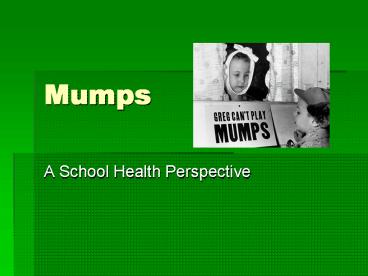Mumps - PowerPoint PPT Presentation
1 / 12
Title:
Mumps
Description:
Mumps is a disease caused by a virus that usually spreads through saliva and can ... pain gets worse when the child swallows, talks, chews, or drinks acidic juices ... – PowerPoint PPT presentation
Number of Views:1020
Avg rating:3.0/5.0
Title: Mumps
1
Mumps
- A School Health Perspective
2
What are the Mumps?
- Mumps is a disease caused
by a virus that
usually spreads through
saliva and can infect
many parts of the body,
especially the parotid
salivary glands. - These glands are found toward the back of each
cheek, in the area between the ear and jaw. In
cases of mumps, these glands typically swell and
become painful.
3
http//www.meningitis.org
4
What are the signs and symptoms?
- Fever of up to 103 degrees Fahrenheit (39.4
degrees Celsius) - Earache
- In teen boys, painful swelling of the testicles
- In teen girls, painful swelling of the ovaries
- Headache
- Loss of appetite
- Swelling and pain in the parotid glands, making
the child look like a hamster with food in its
cheeks. The glands usually become increasingly
swollen and painful over a period of 1 to 3 days.
The pain gets worse when the child swallows,
talks, chews, or drinks acidic juices (like
orange juice) - Complications include meningitis, deafness, and
inflammation of joints. - Infection during pregnancy may kill or severely
harm the fetus.
5
What are the incubation and contagious periods?
- Incubation period is 16 to 18 days.
- Contagious period From 1 to 2 days before to 5
days after swelling of glands.
6
How is it spread?
- Direct contact with tiny drops of fluid from the
mouth and nose of someone who is infected. - It can be passed to others through sneezing,
coughing, or even laughing. - The virus can also spread to other people through
direct contact, such as picking up tissues or
using drinking glasses that have been used by the
infected person.
7
How can I control it?
- Mumps can be prevented by vaccination. The
vaccine can be given alone or as part of the
measles-mumps-rubella (MMR) immunization, which
is usually given to children at 12 to 15 months
of age. A second dose of MMR is generally given
at 4 to 6 years of age. - As is the case with all immunization schedules,
there are important exceptions and special
circumstances.If they haven't already received
them, students who are attending colleges and
other post-high school institutions should be
sure they have had two doses of the MMR vaccine. - During a measles outbreak, your doctor may
recommend additional shots of the vaccine, if
your child is 1 to 4 years old. Your child's
doctor will have the most current information.
8
What are the roles of the teacher and family?
- Report infections to staff in charge of decision
making. - Report the infection to the health department.
- Refer the child to a health professional.
- Ensure up-to-date immunization of children,
staff, volunteers, and family members with MMR
vaccine.
9
Exclude from group settings?
- Yes, as soon as it is suspected.
- The mumps virus is contagious.
- People who have mumps are most contagious from 2
days before symptoms begin to 6 days after they
end. The virus can also spread from people who
are infected but have no symptoms.
10
Readmit to Group Setting?
- Nine days after onset of swelling.
- When the child is able to participate and staff
determine they can care for the child.
11
Mumps in Louisiana
12
Mumps in Louisiana
- In Louisiana, the incidence of mumps decreased
from 0.25 per 100,000 population in 1999 to 0.02
per 100,000 population in 2003. However, in 2004,
there was a sharp increase to 0.20 per 100,000
population. - In 2004, Louisiana had the highest rate among
southern states. Most of the southern states had
lower incidence rates in 2004, except for
Louisiana and Texas as compared to US. - The United States in 2004, had shown a decrease
in the incidence rate of mumps from 0.14 per
100,000 population in 1999 to 0.09 per 100,000
population. - http//www.dhh.louisiana.gov/offices/miscdocs/docs
-249/recent/LaIDAnnual_Mumps2004.pdf































